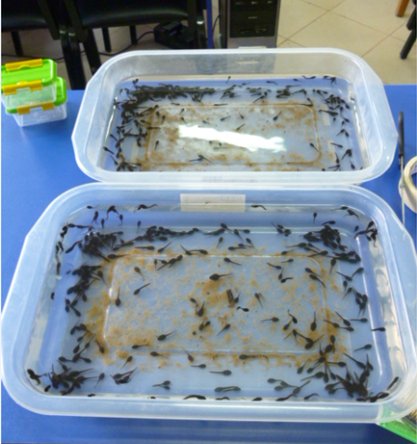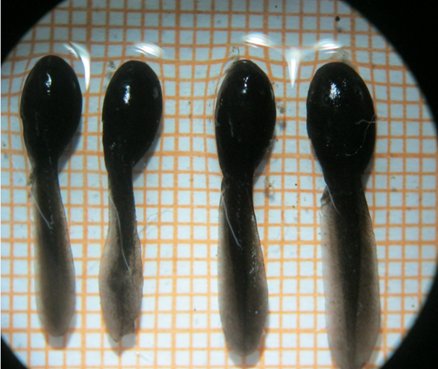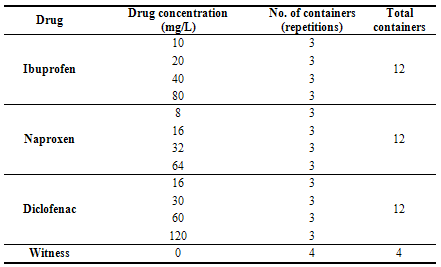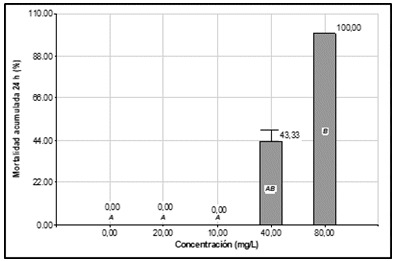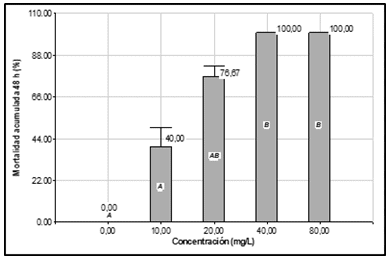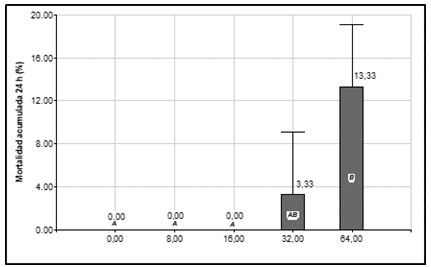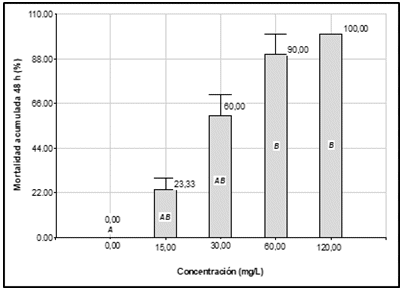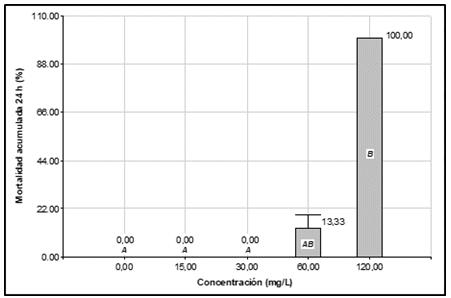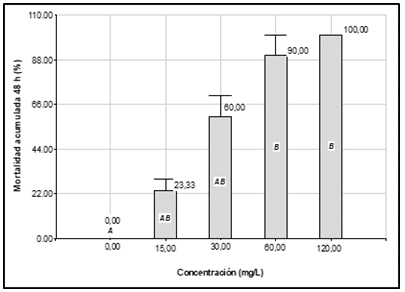Services on Demand
Journal
Article
Indicators
-
 Cited by SciELO
Cited by SciELO -
 Access statistics
Access statistics
Related links
-
 Similars in
SciELO
Similars in
SciELO  uBio
uBio
Share
Journal of the Selva Andina Research Society
On-line version ISSN 2072-9294
J. Selva Andina Res. Soc. vol.11 no.2 La Paz 2020
https://doi.org/10.36610/j.jsars.2020.110200114x
Research Note
Mortality in juvenile stages of the Andean Spiny Toad Rhinella spinulosa (Wiegman 1843): an indicator of waters contaminated by anti-inflammatory drugs
Mortalidad en estadios juveniles del Sapo Espinoso Andino Rhinella spinulosa (Wiegman 1843): un indicador de aguas contaminadas por medicamentos antiinflamatorios
Rayme-Chalco Marisol, Tenorio-Bautista Saturnino Martín* ![]()
National University of San Cristóbal de Huamanga
Biological Sciences Faculty
Portal Independencia N ° 57.
Huamanga-Ayacucho.
Perú.
Tel: (066)312510 – (066)312230.
*Contact address: National University of San Cristóbal de Huamanga. Biological Sciences Faculty. Portal Independencia N ° 57. Huamanga-Ayacucho. Perú. Tel: (066)312510 – (066)312230.
Saturnino Martín Tenorio-Bautista
E-mail address: marte1901@hotmail.com
J. Selva Andina Res. Soc. 2020; 11(2):114-129.
The ID of article: 133/JSARS/2020
Record from the article.
Recibido febrero 2020.
Devuelto abril 2020.
Aceptado junio 2020.
Disponible en línea, agosto 2020.
Resumen
El experimento se realizó en el laboratorio de Biodiversidad y Sistema de Información Geográfica de la Facultad de Ciencias Biológicas de la Universidad Nacional de San Cristóbal de Huamanga, se construyeron 40 UE constituidas por envases de plástico de 1 L de capacidad, con la concentración de cada fármaco además de contar con unidades de control sin presencia de fármaco. En cada UE se colocó 10 unidades de estadios inmaduros de Rhinella spinulosa (Wiegman 1843), con un tamaño aproximado de 2 a 2.5 cm, para luego determinar la mortalidad generada durante las 24 y 48 h de exposición. De los resultados se puede observar que los porcentajes de mortalidad, fueron estadísticamente diferentes (p<0.05), según la concentración de los fármacos en las UE, registrándose para el ibuprofeno mortalidades de 43.33 y 100% a 40 y 80 mg/L de concentración durante 24 h y 40, 76.67 y 100% a 10; 20 y 40 mg/L de concentración a las 48 h de exposición, para el naproxeno se obtuvo una mortalidad de 3.33 y 13.33% a 32 y 64 mg/L a las 24 h y 23.33, 26.67, 50 y 73.33% a las 8, 16, 32 y 64 mg/L de concentración a las 48 h de exposición, finalmente para el diclofenaco se registró mortalidades de 13.33 y 100% a 60 y 120 mg/L a las 24 h y 23.33; 60, 90 y 100% a 15; 30; 60 y 120 mg/L a las 48 h, reportando, que a medida que se incremente la concentración, aumenta el porcentaje de mortalidad. La CL50 para los tres fármacos fue respectivamente 68.6 mg/L, 106.6 mg/L y 120 mg/L a 24 h de exposición y de 13.47 mg/L, 104.6 mg/L y 29.8 mg/L a 48 h, señalando así que la CL50 disminuye a medida que el tiempo de exposición se incrementa.
Palabras clave: Mortalidad acumulada, aguas contaminadas por fármacos, estadios inmaduros de Rhinella spinulosa, CL50.
Abstract
This research has been developed in the Biodiversity and Geographic Information System Laboratory at the Faculty of Biological Sciences of National University of San Cristobal de Huamanga. Forty experimental units of 1L round plastic containers were built with different concentrations of anti-inflammatory drugs and control units. Ten immature specimens of Rhinella spinulosa (Wiegman 1843) about 2 to 25 cm were placed in each experimental unit to determine mortality rates during continuous exposure at 24 and 48 h. As a result, mortality percentages obtained were statistically different (p <0.05); ibuprofen has generated a mortality of 43.33 and 100% at 40 and 80 mg/L of concentration for 24 hours and 40, 76.67 and 100% a 10; 20 and 40 mg/L of concentration for 48 hours, naproxen 3.33 and 13.33% at 32 and 64 mg/L of concentration for 24 hours and 23.33; 26.67; 50 and 73.33% at 8, 16; 32 y 64 mg/L of concentration for 48 hours, and diclofenac 13.33 y 100% at 60 y 120 mg/L for 24 hours and 23.33; 60, 90 y 100% at 15; 30; 60 y 120 mg/L for 48 hours. The LC50 was respectively: 68.6 mg / L, 106.6 mg / L and 120 mg / L for 24 hours and 13.47 mg / L, 104.6 mg / L and 29.8 mg / L for 48 hours, showing that as the exposure time decreases the lethal concentration increase.
Keywords: Accumulated mortality, waters contaminated by drugs, immature stages of Rhinella spinulosa, LC50.
Introduction
Water is a vital liquid for the existence of everything organism. However, this resource is threatened by rapid population growth and hence the contamination. The toxicity produced for contaminants such as heavy metals, hydrocarbons, pesticides, and fertilizers in aquatic environments have been widely evaluated1, few are the studies on the effect of pharmaceutical products (FP), mainly of non-inflammatory anti steroids (NSAIDs) (ibuprofen, naproxen, and diclofenac).
Medications have their importance in practice medical, with beneficial (and/or side) effects in human and veterinary health, widely recognized. However, the area where we lack a global vision is to understand what happens when these are discharged into the environment, either through consumption or as non-used or expired. Residues have been detected of several types of drugs in the environment, such as surface water, groundwater, soil, air, and biota. Such a widespread occurrence raises the question of whether a concentration of drugs in the environment represents a risk to the biota or humans2. The drugs detected in higher concentrations in the input water were NSAIDs, hypolipidemic, beta-blockers, and anti-histamines, the concentrations were analyzed of pharmaceuticals, disinfectants, and drugs of abuse at in and out. Pollutants whose concentrations on the way out, they held their own concerning at the entrance were: diazepam, diclofenac, enalapril and EDDP (methadone metabolite)3,4.
What has aroused the most concern has was the discovery of some of these as ibuprofen, diclofenac, and carbamazepine) in drinking water. This contamination produces changes that affect the functioning of biological processes, generating chronic toxic effects, which cause a decrease in reproduction, death in the process of embryogenesis, of newborns, deformations in growth, skin damage, finally reduction in the population of the flora and fauna inhabitants natural to the aquatic environment5-7. The pollution produced by contaminants such as metals heavy metals, hydrocarbons, and pesticides in environments has been widely evaluated, but few are the studies on the effect of FPs8,9. The main routes of contamination are related to the consumption and excretion of drugs and its metabolites in urine, feces that contaminate the water environment6.
NSAIDs are the most widely used pharmacological group consumed globally with or without a doctor's prescription, especially for the symptomatic treatment of various ailments, which are accompanied by acute pain or chronic10, currently constitute one of the most prescribed and consumed pharmacological groups in the world, for its free sale, for use in various painful syndromes, hence the inescapable focus on aspects of your security11. FPs are substances that attempt to cure, mitigate or prevent in its application in the human or animal body, due to its intense use and extensive enter the environment each year, and estimate that their quantity is similar to the total amount of pesticides used during the same period9,12,13.
The most common forms of negative effects are the decline in reproduction, death in the process of embryogenesis and newborns, growth deformities, skin damage, and finally reduction in the population of the flora and fauna natural inhabitants of the aquatic environment14,15.
The objectives of the research work were: (i) Assessing mortality in juvenile stages of the Toad Spiny Andean Rhinella spinulosa (Wiegman 1843): an indicator of water polluted by nonsteroidal anti-inflammatory drugs NSAIDs with different concentrations in two times of exposure (24 and 48 h) on their immature states, determined their mortality rate and the calculation of the mean lethal concentration (LC50). (ii) Compare mortality and lethal concentration average (LC50).
Materials and methods
The research work was carried out in the Laboratory of Geographic Information System and Biodiversity of the Faculty of Biological Sciences (LGISB-FBS), at the National University of San Cristobal de Huamanga (NUSCH). Located in the Region Ayacucho, province of Huamanga and district from Ayacucho. Between the geographic coordinates: 13º 08' 42" South Latitude and 74º 13' 17" West Longitude and UTM coordinates 0584386 East, 8546645 North, and 2791 meters above sea level.
Obtaining the immature states of R. spinulosa: They were obtained from the Huatatas river near the city of Ayacucho, was transported in buckets to LGISB-FBS, then they were staged on trays with dechlorinated water, 24 h before the toxicity test, to prevent excreta and organic waste interfere with the results of the experiment. Sayings individuals were selected from a homogeneous size approximately 2 to 2.5 cm, figure 1 y 2.
Figure 1. Trays with immature states of Rhinella spinulosa (Wiegman 1843) ready for the experiment |
|
Figure 2. Measurement of the size of the immature stages Rhinella spinulosa (Wiegman 1843) used for the experiment |
|
3 g of each commercial drug (ibuprofen) was used: 400 mg, naproxen: 550 mg and diclofenac: 50 mg) sold in the city of Ayacucho. Preparation of commercial drug solutions: Different concentrations were elaborated, already that there was no recommended information for each product. Pilot tests were carried out to this end, and from these, the concentrations were determined in table 1.
Table 1. Disposal of containers with different concentrations of drugs |
|
Table 2. Distribution of experimental units according to drug concentration |
|
Population and sample: The immature stages of the R. spinulosa as a test organism, is based that these individuals are resistant to water contaminated, as their habitat is usually in stagnant water, in addition to its availability in large quantities in the summer seasons.
Experimental Unit (EU): One-litre containers of capacity, containing ibuprofen 10, 20 40 and 80 mg/L, naproxen 8, 16, 32 and 64 mg/L and diclofenac 16, 30, 60 and 120 mg/L, respectively, each one with three repeats, plus 10 units of immature states of R. spinulosa. The experiment was installed at 6 a.m., mortality control was recorded every 24 h, considering the mortality accumulated environmental the sum of the dead specimens at 24 and 48 h.
Sampling system: The sampling system through which the amount of drug to the use was randomized, 3 g of each drug was taken commercial, previously crushed, and ground the tablets. To give you randomness in the rows and columns the layout of the EU of drugs plus the immature states of R. spinulosa.
Data collection: The instrument used to data collection was an observation, through which it was possible to determine the number of individuals dead (no movement to the touch with a skewer) at 24 and 48 h of exposure to the drugs.
Preparation of the EU: 40 was considered with three each, consisting of containers of 1 L capacity plastics, with 1 L of water and the concentration of the drug, 10 individuals from states immature R. spinulosa (a recommended number for toxicity studies in which it is used as models to organisms such as insects, amphibians and Fish16). To minimize the effect of defectors not considered (light, noise, etc.) in the study, the EU was located in an isolated environment at an average temperature of 22 °C in the shade, 50% humidity, and 13 h daylight. Two were conditioned 9W aquarium air pumps, using 0.3 cm diameter silicone hoses and stones diffusers, the air intake to each EU was with minimum power to prevent the current form in order not to disturb the natural behavior of the tadpoles.
Once the individuals of R. spinulosa are stabled in the EU, inspections were carried out every 24 h to determine the number of individuals dead, with the help of some skewers touched those immobile individuals, if in the case to remain motionless, they were considered dead and extracted from the experimental units, the same procedure was carried out at 24 and 48 h.
Type of research: Basic - experimental as the objective of the work is to give guidelines on the degree of drug toxicity in water resources, helping to demonstrate that the waste from the drugs behaves like pollutants producing mortality of amphibians and other beings aquatic life, taking as a model the stadiums immature R. spinulosa and experimental already that two variables were taken into account, (i) all three types of drugs, (ii) increasing concentrations.
Statistical analysis: The data obtained were used for the construction of a matrix of data in the Excel software, and then exported to InfoStat17 and MINITAB 1618, were developed tables and figures with statistical trend data and dispersion, to compare the recorded mortalities of individuals in the twelve treatments (three drugs tested in four concentrations) plus a witness, was used the Kruskal-Wallis analysis19, because data did not show normal distribution For the estimation of the average lethal concentration (CL50)16,20, for which the MINITAB 16 software was used18 for statistical analysis pointed out.
Results
Figure 3. Percentage of cumulative mortality from immature stages of R. spinulosa after 24 h of exposure at four ibuprofen Concentrations |
|
| A, AB y B: Categories assigned by the statistical test |
Figure 4. Percentage of cumulative mortality of immature stages of R. spinulosa after 48 h of exposure in four concentrations of ibuprofen |
|
| A, AB y B: Categories assigned by the statistical test |
Table 3. Values of the mean lethal concentration (LC50) and confidence interval at 24 and 48 h of exposure for the three drugs |
|
| CL50: Mean lethal concentration |
Table 4. Kruskal-Wallis test to compare the cumulative mortality percentage of the immature states of R. spinulosa subjected to four increasing concentrations of ibuprofen recorded 24 h after exposure |
|
| Stockings with a common letter are not significantly different (p > 0.05) |
Table 5. Kruskal-Wallis test to compare the cumulative mortality percentage of the immature states of R. spinulosa subjected to four increasing concentrations of ibuprofen recorded 48 h after exposure |
|
| Stockings with a common letter are not significantly different (p > 0.05) |
Table 6. Kruskal-Wallis test to compare the cumulative mortality percentage of the immature states of R. spinulosa subjected to four increasing concentrations of naproxen recorded 24 h after exposure |
|
| Stockings with a common letter are not significantly different (p > 0.05) |
Table 7. Kruskal-Wallis test to compare the cumulative mortality percentage of the immature states of R. spinulosa subjected to four increasing concentrations of naproxen recorded 48 h after exposure |
|
| Stockings with a common letter are not significantly different (p > 0.05) |
Table 8. Kruskal-Wallis test to compare the cumulative mortality percentage of the immature states of R. spinulosa subjected to four increasing concentrations of diclofenac recorded 24 h after exposure |
|
| Stockings with a common letter are not significantly different (p > 0.05) |
Figure 5. Percentage of cumulative mortality of immature states of R. spinulosa after 24 h of exposure in four concentrations of naproxen |
|
| A, AB y B: Categories assigned by the statistical test |
Figure 6. Percentage of cumulative mortality of immature stages of R. spinulosa after 48 h of exposure in four concentrations of naproxen |
|
| A, AB y B: Categories assigned by the statistical test |
Figura 7. Percentage of cumulative mortality of immature stages of R. spinulosa after 24 h of exposure in four concentrations of diclofenaco |
|
| A, AB y B: Categories assigned by the statistical test |
Figura 8. Percentage of cumulative mortality of immature stages of R. spinulosa after 48 h of exposure in four concentrations of diclofenaco |
|
| A, AB y B: Categories assigned by the statistical test |
Table 9. Kruskal-Wallis test to compare the cumulative mortality percentage of the immature states of R. spinulosa subjected to four increasing concentrations of diclofenac registered 48 h after exposure |
|
| Stockings with a common letter are not significantly different (p > 0.05) |
Discussion
In figure 3 and table 4, it can be seen that the mortality increases directly to their concentration, so 10 and 20 mg/L was not recorded, while at 40 and 80 mg/L presents 43.33% and 100% respectively, in the witness had no mortality, hence the mortality would be related by the chemical changes that occur in the aquatic environment due to the presence of the residues and some metabolites of ibuprofen. Kruskal Wallis' test19,21 to compare the environments in the different concentrations, it was found statistical significance (p<0.05), MR was different according to the increase of concentration. By categorizing it according to MR, observed at 10 and 20 mg/L was lower, while at 40 and 80 mg/L they generated higher mortality, being at the same time these similar to each other. The found may be due to the presence of metabolites of the drug, these are poorly degradable in the environment resulting in increased toxicity capacity in animal organs5,9,15. Gonzalez-Naranjo22, reports that ibuprofen has large mobility on the ground, so you will at least find in two environmental compartments: the aquatic and terrestrial and there are no toxicity studies. Muñoz-Escobar & Palacio-Baena20, points out that the growth rate of tadpoles treated with HgCl2 was significantly reduced, especially in the highest concentration, the reduction of weight and length of the tadpoles could be associated with the increased metabolic cost due to the processes of purification and detoxification of cells, to the reduction of the activity of some enzymes.Infac4 reports that there are drugs with toxic effects on various species, which alter the reproduction of fish, in certain cases the toxicity data in humans can be extrapolated to the potential effects on vertebrates. Castro-Pastrana et al.23, warn that some major drugs like ibuprofen, in studies in Canada and Europe have confirmed the presence of this drug in concentrations of the order of μL or surface waters, sediments, biosolids, groundwater, drinking water, and pre-water processed in treatment plants. Silva-Agredo et al.24, recommend that it is necessary to research and implementation of techniques that allow the removal of such substances from bodies of water, through the use of ultrasound waves generated through a piezoelectric can degrade organic contaminants, these results are corroborated by the authors cited above.
In figure 4 and table 5, as noted previously observed that mortality increases to the concentration of the drug, like this, With 10 and 20 mg/L the RM was 40 and 76.67% respectively, while at 40 and 80 mg/L it is 100%. With the Kruskal-Wallis test19,21 to buy the environments of the different concentrations of ibuprofen, statistical significance was found (p<0.05). It is interpreted that the percentages of MR are different in the media tested with different concentrations. When categorizing into as a function of the average values of MR, at 10 and 20 mg/L resulted in lower mortality, while a 40 and 80 mg/L was higher, being at the same time similar between them, the mortality rate increases to lower concentrations because the exposure time that he was subjected to was greater than the previous one. It is also important to note that due to the accumulation of metabolites in the individual produces greater damage, the longer it is exposed. On the other hand, the accumulation of these metabolites causes behavioral alterations of the immature states of R. spinulosa, decreasing its mobility and finally separating the epidermis of the muscles4,6,9,14. In many countries have conducted research that determines the presence of these pollutants, in the Atibaia River of São Paulo (Brazil), studies have been carried out to the determination of 15 emerging contaminants (EC) in surface waters, including ibuprofen. In wastewater from Montevideo, Uruguay, the presence of ibuprofen residues, and other pollutants25,26. In the last decade, he has increased the measurement of pharmaceutical residues, especially in surface water, groundwater, and even in drinking water having adverse effects in flora and fauna and the health of ecosystems, triggering public concern because Ibuprofen was reported in 47 countries in the water environment27. The focus on pollution of water has recently expanded into the so-called "emerging contaminants" or new contaminants, whose presence in the environment is not new, but the potential public health consequences and the environment are not well known, in this study they find to ibuprofen in water samples26. These studies indicate that as the number of pharmaceutical contaminants, many living things in their immature state die or fail to reproduce.
In figure 5 and table 6, the increase in concentration-related mortality, as well as 8 and 16 mg/L was not recorded, while at 32 and 64 mg/L, it observed 3.33% and 13% respectively of mortality, considering that in the witness there was no record any, which indicates that mortality is given by the presence of the drug. When applying the test Kruskal Wallis statistics19,21 to compare the environment recorded in the different concentrations, it was found statistical significance (p<0.05), it allows us to say that the recorded mortality rates differ according to the concentration of the drug naproxen in the EU. When categorizing depending on the mortality generated, 8 and 16 mg/L resulted in lower mortalities, while at 32 and 64 mg/L was higher, but similar between yes. The result is due to the presence of the metabolites of the drug since being present in the middle where the immature states of the are located. R. spinulosa is found, there is a greater possibility that they ingested by these. On the other hand, Jimenez-Cartagena28, mentions that the metabolites of drugs are not completely transformed by which are disposed of to the sewage and other cases to water bodies directly, causing environmental alterations or bioaccumulation in some of the levels of the food chain.
In Figure 6 and Table 7, it can be seen that the mortality increases concerning the concentration of the drug, so at 8 and 16 mg/L there were 23.33 and 26.67%, while at 32 and 64 mg/L, 50% and 73.33% respectively. When performing the Kruskal test Wallis19,21, statistical significance was found (p<0.05), which allows us to point out that the percentages of RM are different in treatments with different concentrations of naproxen. When performing the categorization of concentrations according to the resulting mortality, the concentrations of 8 and 16 mg/L caused less, while at 32 and 64 mg/L caused higher mortalities, but at the same time similar between them. The result may be due to the accumulation of drug metabolites, causing alterations in behavior and physiology of the immature states of R. spinulosa, by decreasing breathing, inhibiting the processes associated with the cell membrane facilitating the production of oxidative stress15. Castro-Pastrana et al.23, mention the ecotoxic potential of most consumed drugs and should be developed eco-pharmacovigilance programs and strengthen the investigation. To assess environmental risks the concentrations are compared planned (or measured) pharmaceuticals in the environment at the expected concentrations without effect (PNEC: Predicted No Effect Concentration), the fruit of standardized laboratory experiments with model organisms, such as algae, daphnia, fish or plants, naproxen is found contaminating the aquatic environment in 45 countries of United Nations, suggesting raising awareness overall on the adverse effects of penetration of drugs in the MA27. The results indicate that higher concentrations of naproxen can be lethal because their consumption increases more and more. Drug consumption in many countries is a figure in tons per year, and many of the more used, including anti-inflammatories, after their is excreted through urine and feces, entering continuously and persistently to the waters residuals5,13.
In Figure 7 and Table 8, mortality increases with the concentration of the drug, so at 15 and 30 mg/L no mortality is recorded, while at 60 and 120 mg/L are recorded at 13.33% and 100% respectively, the witness there was no mortality, and it would be given by the presence of the drug. When applying the statistical test from Kruskal Wallis19,21 to compare the environmental recorded in the different concentrations, it was found statistical significance (p<0.05), allowing to point that the percentages of RMs are different in the EU, at different concentrations of diclofenac. At to carry out the categorization of concentrations into the function to RM, 15 and 30 mg/L did not result in mortality, while at 60 and 120 mg/L they presented greater mortality, but similar to each other. The result described is due to the toxic effect of the metabolites of diclofenac as they are not transformed into their totality when consumed by humans and animals, directly affecting the organism's water by being accumulated in the environment where they live. On the other hand, Valdes-Alanis8, concludes that metabolites enable the production of oxidative stress (increased degree of lipoperoxidation and oxidized proteins, as well as altering the activity of the antioxidant enzymes, superoxide dismutase, catalase, and glutathione peroxidase), as a result, damage to various biomolecules, causing finally death.
In Figure 8 and Table 9, it can be seen that the mortality increases as the concentration of the drug increases, so with 15 and 30 mg/L it 23.33 and 60%, while at 60 and 120 mg/L, 90% and 100% respectively. When performing the Kruskal Wallis19,21 to compare the mortalities accumulated with diclofenac, significance was found in statistics (p<0.05). It allows us to point out that the percentages of RMs are different in the EU, the categorization of the concentrations according to the mortality at 15 and 30 mg/L resulted in lower mortality and at 60 and 120 mg/L exposed higher mortality, but similar among them. Like the results found were already mentioned above is due to the presence of its metabolites, with the that the mortality rate is increasing at lower concentrations the longer it takes time, this is due to the accumulation of the metabolites in the individual, so it produces more damage when it is exposed for a longer period, on the other hand, side, according to the environmental hazard classification and risk assessment of pharmaceutical ingredients In Sweden, diclofenac is classified as dangerous to the environment and is considered also potentially bioaccumulative4,7,9,10. Diclofenac was reported in surface waters by above the levels the PNEC levels (for in English: Predicted no-effect concentration) in 34 countries, which suggests ecotoxicological effects adverse to organisms living in these places27. Moreno-Ortiz et al.29 find the presence of active pharmaceutical ingredients in the environment is of increasing concern, it is have observed various harmful effects of several therapeutic groups such as NSAIDs (diclofenac) about reproduction, kidney failure, death, antibiotic resistance and endocrine disorders in different animal species. Perez-Parada et al.26, mention new pollutants include diclofenac that persists in sewage, and drinking water, in Uruguay as well as in countries in the region, there is no specific regulation of CE, something that other regulations such as the European is under consideration for some substances. A wide range of ECs is being studied in the water environment around the world. This includes pesticides, pharmaceuticals, illicit drugs, among many, which, because of their low concentrations, are not effectively eliminated with the conventional water treatments, these can be accumulated and cause a great impact on health and the environment, and generate some problems like endocrine disruptors and hormone problems, Among others30, veterinary treatment includes must know not only the therapeutic effects derived of the use of certain pharmacological agents, but also the potential environmental risks that its activity can cause, ivermectin is a frequently used antiparasitic in sheep, the veterinary professional must be involved in environmental protection, "Every veterinary medicine should not only be safe concerning the treated animal, but also for consumers, users and the environment"31. For the results reported herein work all three NSAIDs pollute the environments. For the results reported in the present work all three NSAIDs pollute aquatic environments and produce immature state mortality of R. spinulosa and possibly other species aquaculturists.
In Table 3, values of the concentrations lethal averages (LC50) with their intervals of confidence at 24 and 48 h of exposure for the three drugs. It can be seen that the longer the exposure, the LC50 decreases with all three drugs, so for ibuprofen at 24 and 48 h, the LC50 was 68.60 mg/L and 13.47 mg/L respectively, for naproxen was recorded at 106.6 and 104.6 mg/L for 24 and 48 h of exposure and finally for diclofenac, values of 120.8 and 29.8 mg/L for 24 and 48 h exposure. The reported results are congruent with what was stated previously, this is justified by the fact that the lower the LC50 value, the higher toxicity, it should also be noted that, as that the exposure time increases, the values of LC50 are decreasing (this trend observed in all three drugs), which is interpreted that, the longer the time of exposure to a toxic substance, the more toxic effect it will cause. Having given the results, it is argued that the percentages of RMs for each drug were statistically different (p<0.05), depending on the concentration of drugs in the EU, the percentages of RM was increasing as the concentration and the exposure time increases, such was for ibuprofen which recorded mortalities of 40.00%, 76.67% and 100%, naproxen 23.33%, 26.67%, 50% and 73.33% and finally for diclofenac 23.33%, 60%, 90% and 100% % at 48 h of exposure. The LC50 for ibuprofen was 68.60 mg/L and 13.47 mg/L, naproxen 106.6 mg/L, and 104.6 mg/L, and finally for diclofenac 120.8 mg/L and 29.8 mg/L at 24 and 48 h of exposure respectively. The mortality rate was less than 24 h, while at 48 h it was increased in the three drugs studied when making the comparison in concentrations were found that LC50 tends to decrease as the time of exposure to the toxic increases. Iannacone & Alvariño32, reported the ibuprofen used on D. magna produced a value of LC50 at 96 h of 175 mg.L-1, with a RAC (Acute Chronic Ratio) of 1.16 and EP (Ecotoxicity Potential) of 1.28 x 10-4, PNEC (mg.L-1) and a risk ratio of 0.057, with toxic effects. Llanos et al.33, determined LC50 and the effectiveness of eugenol as an anesthetic for various doses on swordfish Xiphophorus helleri (Heckel, 1848). For the determination of LC50 worked with 10 individuals in the control and each one of the triplicate replica concentrations, verifying the effectiveness in doses of 100, 125 and 150 mg.L-1, if the anesthetic produces effects at different concentrations of NSAIDs as they are increasing the dose they die from high concentration. Barros-Santiago & Gámez-Rojas34, determined the CL50-96 of RoundupR 747SG on fry of rainbow trout (Oncorhynchus mykiss), establishing that the value of the CL50-96, with their respective confidence limits, ranged from 0.6251 mg/L and 1.3881 mg/L presenting an average value of 1.0066 mg/L indicating that at this concentration half the organisms exposed to glyphosate die. Espinoza-Quintana & Martínez-Huaroc35, mention that drugs are substances chemicals, used to restore the health of human beings and animals, these effects can produce unexpected responses in microorganisms and plants, due to pharmacokinetic differences, pharmacodynamics, and physiology, research was carried out with Lactuca sativa "lettuce", the acute toxicity of diclofenac was determined of 75mg/3mL, where the CIM50 is 0.076 mg/mL and the LC50 0.402 mg/mL. So these NSAIDs not only produce effects on animals but also on plants, i.e. contamination of soil and water should produce low yields in the breeding of animals and cultivated plants, The latter is usually performed on watering. Ríos-Abad & Padilla-Sagástegui36, when carrying out a research paper on "Ecotoxicological Effect of benzodiazepine and para-aminophenol on larvae of Aedes aegypti," they noted that at one time 24 and 48 h exposure, both drugs had a lethal effect on the larvae, with the difference that at 48 h, the lethal effect of benzodiazepine outperforms para-aminophenol. Oscanoa-Espinoza & Lizaraso-Soto11 in their study "Anti-inflammatory non-steroids: gastrointestinal safety, cardiovascular and renal", in gastrointestinal the average circulating concentrations predicted the value and risk of GI bleeding high for each NSAID37. In cardiovascular safety naproxen, ibuprofen, diclofenac with placebo, pointed out the existence of a significant variation among the different NSAIDs analyzed, with less cardiovascular risk was naproxen, the NSAIDs that exceed 30% risk on several outcomes cardiovascular drugs are ibuprofen, diclofenac, etoricoxib, and lumiracoxib, among others38. Also, the main adverse reactions to NSAIDs at the of the renal system Nderitu et al.39 published results of a meta-analytical study on the influence of NSAIDs in the progression of chronic renal failure, noting that only high doses increase by significantly the progression of that disease.
The relative risk of different NSAIDs included: diclofenac (3.2 95% CI 1.38-7.05), naproxen (2.98 95% CI 0.62-14.21), ibuprofen (2.64 IC 95% 1.01- 6.88). So if in humans these adverse reactions occur when administering these drugs, even more so in the immature states of R. spinulosa subjected to the action of NSAIDs caused them to die from the reactions adverse. Several studies have confirmed that the diclofenac is toxic to birds and has been reported in sufficient quantities in beef carrion in India and is considered to be the main cause of the decline of these birds7,9, all authors The results of the survey are corroborated by the respondents. Zavaleta-Flores40, in the determination of LC50 carried out utilizing bioassays, at different concentrations of mercury chloride (0.01 mg HgCl2/L, 0.1 mg HgCl2/L, and 1 mg HgCl2/L respectively) and a control treatment for a total of four lines test, using fry from Colossoma macropomum with an average weight of 4 g and length standard of 5 cm, fry from this species because of its sensitivity to contamination organic and easy adaptation to be fed artificially, the LC50 of mercury chloride for gamma was 0.23±0.15 mg/L in 96 h. After analyzing enough information from the authors already mentioned, the results obtained in the present work are corroborated, we can point out that the immature state of R. spinulosa, resists some concentration and past exposure time the allowable limits die. Finally, this one research allowed to establish that the percentages of mortality recorded for each drug were statistically different (p<0.05), according to the concentration of the drugs in the units In the experimental phase, the percentages of RMs increased as concentration and time exposure increases.
The mortality rate was less than 24 h, while at 48 h was increased in all three drugs studied, by making the comparison in the concentrations it was found that the LC50 tends to decrease as the time of exposure to the toxic is increased.
Funding Source
Our recognition to the Camisea Socioeconomic Development Fund (FOCAM) that fosters scientific and technological research at the National University of San Cristóbal de Huamanga, for providing the materials and equipment of the Biodiversity Laboratory and Geographic Information System, part of the project "Biogenic capacity and loading of lagoons and high Andean rivers for the promotion of sustainable trout farming in four districts of the department of Ayacucho".
Conflicts of interest
The authors state that there are no conflicts of interest.
Acknowledgment
Our sincere thanks to the National University of San Cristóbal de Huamanga, the Faculty of Biological Sciences and the Professional Training Schools of Pharmacy and Biochemistry, and the Biodiversity Laboratory and Geographic Information System where the experimental. To Dr. Carlos Emilio Carrasco Badajoz for his collaboration and support to make this research possible.
Ethical aspects
All the procedural and experimental aspects were approved by the evaluating committee of the Faculty of Biological Sciences of the National University of San Cristóbal de Huamanga-Peru.
Literature cited
1. Egea Serrano A. Aspectos relevantes en la conservación de anfibios en la región de Murcia: efectos de la contaminación por fertilizantes sobre Pelophylax perezi (Seoane, 1885) [tesis doctoral]. [Murcia]: Universidad de Murcia; 2010 [citado 26 de octubre de 2019]. Disponible: http://hdl.handle.net/10803/11085
2. Mudgal S, De Toni A, Lockwood S, Salès K, Backhaus T, Halling B. Study on the environmental risks of medicinal products. Final Report. Executive Agency for Health and Consumers; 2013 Dec. [citado 15 de octubre de 2019]. 310 p. Contract No.: 2011-6103. Recuperado a partir de: https://ec.europa.eu/health/sites/health/files/files/environment/study_environment.pdf
3. Barceló LD, López de Alda MJ. Contaminación y calidad química del agua: el problema de los contaminantes emergentes. [monografía en Internet]. Barcelona: Fundación Nueva Cultura del Agua. Panel Científico-Técnico de seguimiento de la política de aguas; 2008 [acceso 19 de diciembre de 2019]. Disponible en: http://www.unizar.es/ fnca/varios/panel/15.pdf
4. Agirrezabala JR, Aizpurua I, Albizuri M, Alfonso I, Armendáriz M, Asensio A, et al. Farmacontaminación. Impacto ambiental de los medicamentos. Infac [Internet]. 2016 [citado 5 de octubre de 2016]; 24(10):59-64. Recuperado a partir de: http://files.sld.cu/medicamentos/files/2017/01/INFAC_Vol_24_n_10_farmacontaminacion.pdf
5. Tejada C, Quiñonez E, Peña, M. Contaminantes emergentes en aguas: metabolitos de fármacos. Una revisión. Revista de Facultad de Ciencias Básicas. [Bogotá]: Universidad Militar Nueva Granada 2014 [citado 19 de mayo de 2014]; 10(1):80-101. Recuperado a partir de: https:// revistas.unimilitar.edu.co/index.php/ rfcb/article/ view/341/137
6. Oropesa AL, Moreno JJ, Gómez LJ. Lesiones histopatológicas en peces originadas por la exposición a contaminantes emergentes: recopilando y analizando datos. Rev Toxicol [Internet]. 2017 [citado 5 de enero de 2020]; 34:99-108. Recuperado a partir de: http://rev.aetox.es/wp/wp-content/uploads/2017/12/34.2.3-1.pdf
7. Bedner M, MacCrehan WA. Transformation of Acetaminophen by Chlorination Produces the Toxicants 1,4-Benzoquinone and N-Acetyl-p-benzoquinone. Imine Environ Sci Technol 2006;40(2):516-22. DOI: https://doi.org/10.1021/ es0509073
8. Valdes Alanis A. Evaluación de la toxicidad producida por diclofenaco sobre Daphnia magna [tesis licenciatura]. [México]: Instituto Politécnico Nacional; 2011 [cited 2014 Sep 4]. Disponible en: http://tesis.ipn.mx:8080/xmlui/handle/123456 789/8067
9. Arbeláez Salazar PA. Contaminantes emergentes en aguas residuales y de río y fangos de depuradora [tesis doctoral]. [Tarragona]: Universitat Rovira i Virgili; 2015 [citado 26 de octubre de 2019]. Recuperado a partir de: https://www. tesisenred.net/handle/10803/334397#page=2
10. García Colmenero I, Díaz Franco SD, Zorrilla Mendoza JG, Cortés Chamorro R. Aspectos de seguridad en el tratamiento del dolor con analgésicos antiinflamatorios no esteroides. Rev Sanid Mil 2018;72(5-6):324-31.
11. Oscanoa Espinoza T, Lizaraso Soto F. Antiinflamatorios no esteroides: seguridad gastrointestinal, cardiovascular y renal. Rev Gastroenterol Peru 2015;35(1):63-71.
12. Jjemba PK. Excretion and ecotoxicity of pharmaceutical and personal care products in the environment. Ecotoxicol Environ Saf 2005; 63(1):113-30.DOI: https://doi.org/10.1016/j.ecoenv.2004.11.011
13. Elorriaga Y, Marino DJ, Carriquiriborde P, Ronco AE. Emerging pollutants: pharmaceuticals in the environment. En: Elorriaga Y, Marino DJ, Carriquiriborde P, Ronco AE, editores. 7mo Congreso de Medio Ambiente y Actas 7mo Congreso de Medio Ambiente AUGM: 22 al 24 de mayo de 2012. CIMA. Facultad de Ciencias Exactas [Internet]. La Plata: Universidad Nacional de La Plata; 2012 [citado 3 de noviembre de 2019]. p. 1-9. Recuperado a partir de: http://sedici.unlp.edu.ar/handle/10915/26491
14. Castellanos Gutiérrez M, Solís Cartas U, Faure Bermúdez AI, Villaurrutia Velazco YC. Gastropatía por antinflamatorios no esteroideos en pacientes con enfermedades reumáticas. Rev Cuba Reumatol 2014;16(3):356-64.
15. Halling Sørensen B, Nors Nielsen S, Lanzky PF, Ingerslev F, Holten Lützhøft HC, Jørgensen SE. Occurrence, fate and effects of pharmaceutical substances in the environment- A review. Chemosphere 1998;36(2):357-93. DOI: https://doi.org/10.1016/S0045-6535(97)00354-8
16. Paredes Espinal CE. Riesgo ecológico del sulfato de bario [tesis maestría]. [Lima]: Universidad Nacional Agraria La Molina; 2016 [citado 26 de octubre de 2019]. Disponible: http://repositorio.lamolina.edu.pe/handle/UNALM/2716
17. Balzarini M, González LA, Tablada M, Casanoves F, Di Rienzo JA, Robledo CW. InfoStat Software Estadístico Manual del Usuario Versión 2008 [monografía en Internet]. Córdova: Universidad Nacional de Córdoba; 2008. [acceso 19 de diciembre de 2019]. Disponible en: http://www.researchgate.net/publication/283491340_Infostat _manual_del_usuario
18. Casa Chiluisa PE. El Software Minitab 16 como herramienta de análisis de los datos estadísticos para mejorar la enseñanza aprendizaje en los alumnos de la carrera de ingeniería comercial en el período en el periodo 2014 [tesis licenciatura]. [Latacunga]: Universidad Técnica de Cotopaxi; 2014. [citado 26 de octubre de 2019]. Disponible: http://repositorio.utc.edu.ec/handle/27000/3133
19. Clifford BR, Taylor RA, editores. Bioestadística. México: Pearson Educación; 2008.
20. Muñoz Escobar EM, Palacio Baena J. Efectos del cloruro de mercurio (HgCl2) sobre la sobrevivencia y crecimiento de renacuajos de Dendrosophus bogerti. Actual Biol 2010;32(93):189-97.
21. Corzo JA. Estadística no paramétrica: métodos basados en rangos [Internet]. Bogotá: Universidad Nacional de Colombia; 2005 [citado 22-de octubre de 2019]. 34 p. Recuperado a partir de: https://repositorio.unal.edu.co/handle/unal/53385
22. González Naranjo V. Efectos sinérgicos en el análisis ecotoxicológico del Ibuprofeno. Aproximación cuantitativa del riesgo ambiental. [tesis doctoral]. [Alcalá]: Universidad de Alcalá, 2013 [citado 26 de octe de 2019]. Recuperado a partir de:http://eprints.imdea-agua.org:13000/372/
23. Castro Pastrana LI, Baños Medina MI, López Luna MA, Torres García BL. Ecofarmacovigilancia en México: perspectivas para su implementación. Rev Mex Cienc Farm 2015;46(3):16-40.
24. Silva Agredo J, Giraldo Aguirre AL, Torres Palma RA. Degradación sonoquímica de naproxeno modelo para el tratamiento de aguas que contienen productos farmacéuticos. Rev Invest Univ Quindío (Col.) 2013;24(1):153-60.
25. Reinoso Carrasco JC, Serrano Delgado CY, Orellana Cobos DF. Contaminantes emergentes y su impacto en la salud. Revista de la facultad de Ciencias Médicas. Ref Fac Cienc Médic Univ Cuenca 2017;35(2):55.9.
26. Pérez Parada A, Niell S, Colazzo M, Besila N, Cesio V, Heinzen H. Evaluación preliminar de la ocurrencia de contaminantes emergentes en aguas residuales de Montevideo, Uruguay. En: Pérez Parada A, Niell S, Colazzo M, Besila N, Cesio V, Heinzen H, editores. 7mo Congreso de Medio Ambiente y Actas 7mo Congreso de Medio Ambiente AUGM: 22 al 24 de mayo de 2012. CIMA. Facultad de Ciencias Exactas [Internet]. La Plata: Universidad Nacional de La Plata; 2012 [citado 3 de noviembre de 2019]. p. 1-9. Recuperado a partir de: http://sedici.unlp.edu.ar/bitstream/handle/10915/26665/Documento_completo.pdf?sequence=1&isAllowed=y
27. Frank Andreas W, Beek T, Bergmann A, Carius A, Grüttner G, Hickmann S, et al. Fármacos en el medio ambiente - la perspectiva global: incidencia, efectos y acción cooperativa potencial bajo el SAICM [Internet]. Wörlitzer Platz: German Environment Agency; 2014 [citado 22-de octubre de 2019]. 12 p. Recuperado a partir de: https:// www.umweltbundesamt.de/sites/default/files/medien/378/publikationen/farmacos_en_el_medio_ambiente.pdf
28. Jiménez Cartagena C. Contaminantes orgánicos emergentes en el ambiente: productos farmacéuticos. Rev Lasallista Investing 2011;8(2):143-53.
29. Moreno Ortiz VC, Martínez Núñez JM, Kravzov Jinich J, Pérez Hernández LA, Moreno Bonett C, Altagracia Martínez M. Los medicamentos de receta de origen sintético y su impacto en el medio ambiente. Rev Mex Cienc Farm 2013;44(4):17-29.
30. Gil MJ, Soto AM, Usma JI, Gutiérrez OD. Emerging contaminants in waters: effects and possible treatments. Rev P+L 2012;7(2):52-73.
31. García Salazar B, Hernández Moreno D, Soler Rodríguez F, Pérez López M. Empleo de Ivermectina como parasiticida en ovino: posibles efectos tóxicos y repercusiones ambientales. An Vet Murcia 2011;27: 23-32. DOI: https://doi.org/10.6018/j/160111
32. Iannacone J, Alvariño L. Evaluación del riesgo acuático de siete productos farmacéuticos sobre Daphnia magna. Ecol Apl 2009;8(2):71.80. DOI: https://doi.org/10.21704/rea.v8i1-2.384
33. Llanos C, Monteza C, Scotto C. Determinación de la concentración letal media (CL50) y eficacia del eugenol como anestésico sobre Xiphophorus helleri (Heckel, 1848) (Cyprinodontiformes: Poecilidae). Rev Investig Vet Perú 2012; 23(4):429-40.
34. Barros Santiago CP, Gámez Rojas VE. Determinación de la concentración letal media (CL50-96) del Glifosato RoundupR 747SG, por medio de bioensayos utilizando alevinos de trucha arco iris (Oncorhynchus mykiss) [tesis licenciatura]. [Bogotá]: Universidad de la Salle; 2008 [citado 26 de noviembre de 2019]. Recuperado a partir de: http://www.mamacoca.org/docs_de_base/Fumigas/Barrros_y_Gamez_Concentracion_glifosato_UdeLaSalle_dic2008.pdf
35. Espinoza Quintana C, Martínez Huaroc RS. Evaluación de la toxicidad aguda producida por amoxicilina, dexametasona y diclofenaco, en Lactuca sativa (lechuga) [tesis licenciatura]. [Tarragona]: Universidad Privada de Huancayo “Franklin Roosevelt”; 2016 [citado 26 de noviembre de 2019]. Recuperado a partir de: http://repositorio.uroosevelt.edu.pe/xmlui/handle/ROOSEVELT/29
36. Ríos Abad I, Padilla Sagástegui SE. Efecto ecotoxicológico de benzodiacepina y para-aminofe nol sobre larvas de Aedes aegypti. Sciéndo 2015;17(2):57-69.
37. Massó González EL, Patrignani P, Tacconelli S, García Rodríguez LA. Variability among nonsteroidal antiinflammatory drugs in risk of upper gastrointestinal bleeding Arthritis Rheum 2010; 62(6):1592-601. DOI: https://doi.org/10. 1002/ art.27412
38. Trelle S, Reichenbach S, Wandel S, Hildebrand P, Tschannen B, Villiger PM, et al. Cardiovascular safety of non-steroidalanti-inflammatory drugs: network meta-analysis. BMJ. 2011;342: c7086. DOI: https://doi.org/10.1136/ bmj.c7086
39. Nderitu P, Doos L, Jones PW, Davies SJ, Kadam UT. Non-steroidal Anti-Inflammatory Drugs and Chronic Kidney Disease Progression: A Systematic Review. Fam Pract 2013; 30(3):247-55. DOI: https://doi.org/10.1093/fampra/cms086
40. Zavaleta Flores JO. Concentración Letal Media (CL50) del cloruro de mercurio (HgCl2) sobre alevinos de gamitana Colossoma macropomum (CUVIER, 1818) en ambientes controlados [tesis licenciatura]. [Iquitos]: Universidad Nacional de la Amazonía Peruana; 2016 [citado 26 de octubre de 2019]. Recuperado a partir de: http:// repositorio.unapiquitos.edu.pe/handle/UNAP/3296
______________
Editor's Note:
Journal of theSelva Andina Research Society (JSARS) remains neutral regarding jurisdictional claims published on maps and institutional affiliations.
2. Mudgal S, De Toni A, Lockwood S, Salès K, Backhaus T, Halling B. Study on the environmental risks of medicinal products. Final Report. Executive Agency for Health and Consumers; 2013 Dec. [citado 15 de octubre de 2019]. 310 p. Contract No.: 2011-6103. Recuperado a partir de: https://ec.europa.eu/health/sites/health/files/files/environment/study_environment.pdf [ Links ]
3. Barceló LD, López de Alda MJ. Contaminación y calidad química del agua: el problema de los contaminantes emergentes. [monografía en Internet]. Barcelona: Fundación Nueva Cultura del Agua. Panel Científico-Técnico de seguimiento de la política de aguas; 2008 [acceso 19 de diciembre de 2019]. Disponible en: http://www.unizar.es/ fnca/varios/panel/15.pdf
4. Agirrezabala JR, Aizpurua I, Albizuri M, Alfonso I, Armendáriz M, Asensio A, et al. Farmacontaminación. Impacto ambiental de los medicamentos. Infac [Internet]. 2016 [citado 5 de octubre de 2016]; 24(10):59-64. Recuperado a partir de: http://files.sld.cu/medicamentos/files/2017/01/INFAC_Vol_24_n_10_farmacontaminacion.pdf
5. Tejada C, Quiñonez E, Peña, M. Contaminantes emergentes en aguas: metabolitos de fármacos. Una revisión. Revista de Facultad de Ciencias Básicas. [Bogotá]: Universidad Militar Nueva Granada 2014 [citado 19 de mayo de 2014]; 10(1):80-101. Recuperado a partir de: https:// revistas.unimilitar.edu.co/index.php/ rfcb/article/ view/341/137
6. Oropesa AL, Moreno JJ, Gómez LJ. Lesiones histopatológicas en peces originadas por la exposición a contaminantes emergentes: recopilando y analizando datos. Rev Toxicol [Internet]. 2017 [citado 5 de enero de 2020]; 34:99-108. Recuperado a partir de: http://rev.aetox.es/wp/wp-content/uploads/2017/12/34.2.3-1.pdf
7. Bedner M, MacCrehan WA. Transformation of Acetaminophen by Chlorination Produces the Toxicants 1,4-Benzoquinone and N-Acetyl-p-benzoquinone. Imine Environ Sci Technol 2006;40(2):516-22. DOI: https://doi.org/10.1021/ es0509073 [ Links ]
8. Valdes Alanis A. Evaluación de la toxicidad producida por diclofenaco sobre Daphnia magna [tesis licenciatura]. [México]: Instituto Politécnico Nacional; 2011 [cited 2014 Sep 4]. Disponible en: http://tesis.ipn.mx:8080/xmlui/handle/123456 789/8067
9. Arbeláez Salazar PA. Contaminantes emergentes en aguas residuales y de río y fangos de depuradora [tesis doctoral]. [Tarragona]: Universitat Rovira i Virgili; 2015 [citado 26 de octubre de 2019]. Recuperado a partir de: https://www. tesisenred.net/handle/10803/334397#page=2
10. García Colmenero I, Díaz Franco SD, Zorrilla Mendoza JG, Cortés Chamorro R. Aspectos de seguridad en el tratamiento del dolor con analgésicos antiinflamatorios no esteroides. Rev Sanid Mil 2018;72(5-6):324-31. [ Links ]
11. Oscanoa Espinoza T, Lizaraso Soto F. Antiinflamatorios no esteroides: seguridad gastrointestinal, cardiovascular y renal. Rev Gastroenterol Peru 2015;35(1):63-71. [ Links ]
12. Jjemba PK. Excretion and ecotoxicity of pharmaceutical and personal care products in the environment. Ecotoxicol Environ Saf 2005; 63(1):113-30.DOI: https://doi.org/10.1016/j. ecoenv.2004.11.011 [ Links ]
13. Elorriaga Y, Marino DJ, Carriquiriborde P, Ronco AE. Emerging pollutants: pharmaceuticals in the environment. En: Elorriaga Y, Marino DJ, Carriquiriborde P, Ronco AE, editores. 7mo Congreso de Medio Ambiente y Actas 7mo Congreso de Medio Ambiente AUGM: 22 al 24 de mayo de 2012. CIMA. Facultad de Ciencias Exactas [Internet]. La Plata: Universidad Nacional de La Plata; 2012 [citado 3 de noviembre de 2019]. p. 1-9. Recuperado a partir de: http://sedici.unlp.edu .ar/handle/10915/26491
14. Castellanos Gutiérrez M, Solís Cartas U, Faure Bermúdez AI, Villaurrutia Velazco YC. Gastropatía por antinflamatorios no esteroideos en pacientes con enfermedades reumáticas. Rev Cuba Reumatol 2014;16(3):356-64. [ Links ]
15. Halling Sørensen B, Nors Nielsen S, Lanzky PF, Ingerslev F, Holten Lützhøft HC, Jørgensen SE. Occurrence, fate and effects of pharmaceutical substances in the environment- A review. Chemosphere 1998;36(2):357-93. DOI: https://doi. org/10.1016/S0045-6535(97)00354-8 [ Links ]
16. Paredes Espinal CE. Riesgo ecológico del sulfato de bario [tesis maestría]. [Lima]: Universidad Nacional Agraria La Molina; 2016 [citado 26 de octubre de 2019]. Disponible: http://repositorio. lamolina.edu.pe/handle/UNALM/2716
17. Balzarini M, González LA, Tablada M, Casanoves F, Di Rienzo JA, Robledo CW. InfoStat Software Estadístico Manual del Usuario Versión 2008 [monografía en Internet]. Córdova: Universidad Nacional de Córdoba; 2008. [acceso 19 de diciembre de 2019]. Disponible en: http://www. researchgate.net/publication/283491340_Infostat _manual_del_usuario
18. Casa Chiluisa PE. El Software Minitab 16 como herramienta de análisis de los datos estadísticos para mejorar la enseñanza aprendizaje en los alumnos de la carrera de ingeniería comercial en el período en el periodo 2014 [tesis licenciatura]. [Latacunga]: Universidad Técnica de Cotopaxi; 2014. [citado 26 de octubre de 2019]. Disponible: http://repositorio.utc.edu.ec/handle/27000/3133
19. Clifford BR, Taylor RA, editores. Bioestadística. México: Pearson Educación; 2008.
20. Muñoz Escobar EM, Palacio Baena J. Efectos del cloruro de mercurio (HgCl2) sobre la sobrevivencia y crecimiento de renacuajos de Dendrosophus bogerti. Actual Biol 2010;32(93):189-97. [ Links ]
21. Corzo JA. Estadística no paramétrica: métodos basados en rangos [Internet]. Bogotá: Universidad Nacional de Colombia; 2005 [citado 22-de octubre de 2019]. 34 p. Recuperado a partir de: https://repositorio.unal.edu.co/handle/unal/53385
22. González Naranjo V. Efectos sinérgicos en el análisis ecotoxicológico del Ibuprofeno. Aproximación cuantitativa del riesgo ambiental. [tesis doctoral]. [Alcalá]: Universidad de Alcalá, 2013 [citado 26 de octe de 2019]. Recuperado a partir de:http://eprints.imdea-agua.org:13000 /372/
23. Castro Pastrana LI, Baños Medina MI, López Luna MA, Torres García BL. Ecofarmacovigilancia en México: perspectivas para su implementación. Rev Mex Cienc Farm 2015;46(3):16-40. [ Links ]
24. Silva Agredo J, Giraldo Aguirre AL, Torres Palma RA. Degradación sonoquímica de naproxeno modelo para el tratamiento de aguas que contienen productos farmacéuticos. Rev Invest Univ Quindío (Col.) 2013;24(1):153-60. [ Links ]
25. Reinoso Carrasco JC, Serrano Delgado CY, Orellana Cobos DF. Contaminantes emergentes y su impacto en la salud. Revista de la facultad de Ciencias Médicas. Ref Fac Cienc Médic Univ Cuenca 2017;35(2):55.9. [ Links ]
26. Pérez Parada A, Niell S, Colazzo M, Besila N, Cesio V, Heinzen H. Evaluación preliminar de la ocurrencia de contaminantes emergentes en aguas residuales de Montevideo, Uruguay. En: Pérez Parada A, Niell S, Colazzo M, Besila N, Cesio V, Heinzen H, editores. 7mo Congreso de Medio Ambiente y Actas 7mo Congreso de Medio Ambiente AUGM: 22 al 24 de mayo de 2012. CIMA. Facultad de Ciencias Exactas [Internet]. La Plata: Universidad Nacional de La Plata; 2012 [citado 3 de noviembre de 2019]. p. 1-9. Recuperado a partir de: http://sedici.unlp.edu.ar/bitstream/ handle/10915/26665/Documento_completo.pdf?sequence=1&isAllowed=y
27. Frank Andreas W, Beek T, Bergmann A, Carius A, Grüttner G, Hickmann S, et al. Fármacos en el medio ambiente - la perspectiva global: incidencia, efectos y acción cooperativa potencial bajo el SAICM [Internet]. Wörlitzer Platz: German Environment Agency; 2014 [citado 22-de octubre de 2019]. 12 p. Recuperado a partir de: https:// www.umweltbundesamt.de/sites/default/files/medien/378/publikationen/farmacos_en_el_medio_ambiente.pdf
28. Jiménez Cartagena C. Contaminantes orgánicos emergentes en el ambiente: productos farmacéuticos. Rev Lasallista Investing 2011;8(2):143-53. [ Links ]
29. Moreno Ortiz VC, Martínez Núñez JM, Kravzov Jinich J, Pérez Hernández LA, Moreno Bonett C, Altagracia Martínez M. Los medicamentos de receta de origen sintético y su impacto en el medio ambiente. Rev Mex Cienc Farm 2013;44(4):17-29. [ Links ]
30. Gil MJ, Soto AM, Usma JI, Gutiérrez OD. Emerging contaminants in waters: effects and possible treatments. Rev P+L 2012;7(2):52-73. [ Links ]
31. García Salazar B, Hernández Moreno D, Soler Rodríguez F, Pérez López M. Empleo de Ivermectina como parasiticida en ovino: posibles efectos tóxicos y repercusiones ambientales. An Vet Murcia 2011;27: 23-32. DOI: https://doi.org/ 10. 6018/j/160111 [ Links ]
32. Iannacone J, Alvariño L. Evaluación del riesgo acuático de siete productos farmacéuticos sobre Daphnia magna. Ecol Apl 2009;8(2):71.80. DOI: https://doi.org/10.21704/rea.v8i1-2.384 [ Links ]
33. Llanos C, Monteza C, Scotto C. Determinación de la concentración letal media (CL50) y eficacia del eugenol como anestésico sobre Xiphophorus helleri (Heckel, 1848) (Cyprinodontiformes: Poecilidae). Rev Investig Vet Perú 2012; 23(4):429-40. [ Links ]
34. Barros Santiago CP, Gámez Rojas VE. Determinación de la concentración letal media (CL50-96) del Glifosato RoundupR 747SG, por medio de bioensayos utilizando alevinos de trucha arco iris (Oncorhynchus mykiss) [tesis licenciatura]. [Bogotá]: Universidad de la Salle; 2008 [citado 26 de noviembre de 2019]. Recuperado a partir de: http://www.mamacoca.org/docs_de_base/Fumigas/Barrros_y_Gamez_Concentracion_glifosato_UdeLaSalle_dic2008.pdf
35. Espinoza Quintana C, Martínez Huaroc RS. Evaluación de la toxicidad aguda producida por amoxicilina, dexametasona y diclofenaco, en Lactuca sativa (lechuga) [tesis licenciatura]. [Tarragona]: Universidad Privada de Huancayo Franklin Roosevelt; 2016 [citado 26 de noviembre de 2019]. Recuperado a partir de: http://repositorio.uroosevelt.edu.pe/xmlui/handle/ROOSEVELT/29
36. Ríos Abad I, Padilla Sagástegui SE. Efecto ecotoxicológico de benzodiacepina y para-aminofe nol sobre larvas de Aedes aegypti. Sciéndo 2015;17(2):57-69. [ Links ]
37. Massó González EL, Patrignani P, Tacconelli S, García Rodríguez LA. Variability among nonsteroidal antiinflammatory drugs in risk of upper gastrointestinal bleeding Arthritis Rheum 2010; 62(6):1592-601. DOI: https://doi.org/10. 1002/ art.27412 [ Links ]
38. Trelle S, Reichenbach S, Wandel S, Hildebrand P, Tschannen B, Villiger PM, et al. Cardiovascular safety of non-steroidalanti-inflammatory drugs: network meta-analysis. BMJ. 2011;342: c7086. DOI: https://doi.org/10.1136/ bmj.c7086
39. Nderitu P, Doos L, Jones PW, Davies SJ, Kadam UT. Non-steroidal Anti-Inflammatory Drugs and Chronic Kidney Disease Progression: A Systematic Review. Fam Pract 2013; 30(3):247-55. DOI: https://doi.org/10.1093/fampra/cms086 [ Links ]











 text in
text in 

